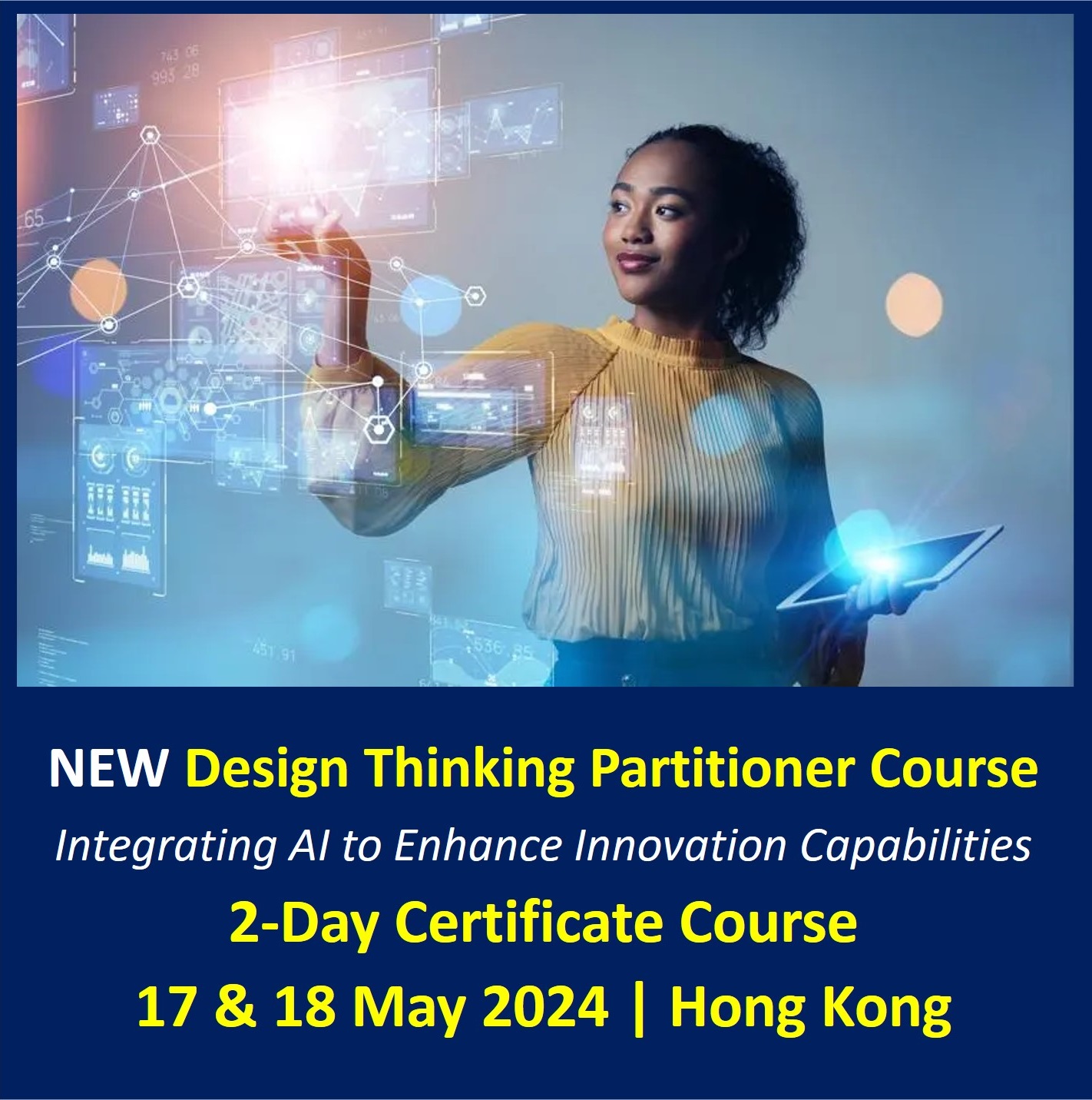English | 繁體中文


Aims | Target Audience | Objectives | Date, Fee & Registration | Details | Previous Classes
Part 1: Course Version and Aims
This is the 2024 edition of the course, now enhanced with content on Artificial Intelligence. Upon completion of the course, you will be fully prepared to apply Design Thinking principles and techniques, integrated with AI insights, in your professional endeavors.
The Aim is to help business professionals accelerate product enhancement, service improvement, and business model innovation by integrating Artificial Intelligence into Human-Centered business innovation processes.
This interactive course will equip you with the Design Thinking mindset, tools, and skills to kick-start bold innovation. It will also introduce how to leverage Artificial Intelligence to refine and implement these innovations. You will embark on a highly interactive learning journey, engaging in group work on a challenge under the guidance of skilled facilitators, with a focus on AI-enhanced Design Thinking processes.
This course is meticulously designed to specifically accommodate business leaders who are “EVEN unfamiliar” with Design Thinking and the use of AI tools such as Chat GPT, DALL-E, and Stormz.
Part 2: Target Audience:
- Innovation Teams: Team leaders responsible for leading corporate transformation or business improvement initiatives.
- Business Managers and Owners: Suited for professionals seeking to innovate their products or services.
- Business Professionals: Designed for individuals eager to expand their creative problem-solving capabilities.
- Business leaders: Perfect for leaders looking to enhance corporate innovation effectiveness or cultivate a culture of innovation.
Your Major Take-Away:
In today’s highly competitive world, having innovative designs for new initiatives is not enough. You must transform your innovative designs into new products or services to generate revenue. Thus, AI methods combined with Design Thinking tools and techniques will play a crucial role. In the two-day course, participants will experience four main stages, from “AI-based Market Demand Analysis” to “Implementation of AI-driven Solutions,” including Discovering users’ unmet, hidden, and potential needs; Defining high-return business opportunities; Developing all-rounded innovative ideas, and Delivering quantifiable business innovation results.

Part 3: Major Learning Objectives
Upon completion of the new program, you will be able to
(1) Master Design Thinking Principles, Values and Execution Framework (Double Diamond Model)
(2) Apply Design Thinking approaches to advanced problem-solving tasks, product or service innovations, & business transformation
(3) Conduct Quantitative and Qualitative Analysis of All-rounded User Demands
(4) Explore how to Achieve the Optimal balance between AI efficiency and Human Empathy in Human-Centered Innovation
(5) Know the Optimal Integration of Design Thinking Methods and Artificial Intelligence Techniques such as Chat GPT, DALL-E, and Stormz. Specific applications include:
- Using comprehensive stakeholder relationship analysis to create a Stakeholder Map: AI tools can identify key stakeholders, providing insights to more accurately understand their needs and expectations, thereby facilitating more effective stakeholder management.
- Conducting Design Research with deeper research question design: AI tools help deepen the design of research questions, making research more targeted and efficient.
- Designing a Persona Map with more personalized simulation methods: AI tools can help create more refined personas, providing a comprehensive portrayal based on user behavior data and psychological analysis, making design solutions more aligned with actual users.
- Building a Customer Journey Map with more meticulous methods: AI’s capability to analyze data can track customer interactions in detail, creating more accurate and detailed customer journey maps.
- Executing Ideation Processes with faster and broader methods: AI can accelerate idea generation processes and make brainstorming more diverse, and enrich ideation.
- Creating a Service Scenario Map with Higher Fidelity Simulation Methods: AI tools can simulate realistic service scenarios, providing dynamic visualizations and interactive experiences. This allows teams to foresee and evaluate potential issues and outcomes of service implementation in the early stages, thereby making adjustments and optimizing service design proactively.
Learning approach: Learning by Doing (Lecturing: 20% | Case study: 20% | Practices: 50% | Reflection: 10% )
Part 4: Date, Fee and Registration:
Hong Kong Classes:
23rd Cohort: 2-Day with 2-Follow-Up Sessions: 19 & 20 Jul + 2 One-hour Online Team Follow-Up (will be scheduled on Friday evening)
24th Cohort: “4 Half-day” Format: 5, 12, 19 & 26 Sep
Mainland China Classes:
Guangzhou: 26 & 27 Jul | Shanghai: 24 & 25 May
Time: 7.5 hours per day (9:30 am to 1:00 pm and 2:00 pm to 6:00 pm)
Language: Cantonese Presentation with English Materials
Mode: Face-to-Face Training Mode
Tuition Fee:
For HK Classes: HK$ 6,500 (Early Bird | 1-month before the first lesson) | HK$ 7,000 (Standard Price)
For Mainland China Classes: RMB 6,500 (Early Bird | 1-month before the first lesson) | RMB 7,000 (Standard Price)


Part 5: Course Details
**Download the Course Pamphlet**
Part 6: Previous Classes
The previous 21 public classes of the DTA Design Thinking Fundamentals course are listed below:
2023 (19th to 21th Cohort): 21 Oct | 22 Jul | 14 Apr
2022 (15th to 18th Cohort): 20 Oct | 7 Jul | 26 Apr | 17 Mar
2021 (10th to 14th Cohort): 2 Dec | 12 Oct | 19 Aug | 11 Mar | 16 Jan
2020 (5th to 9th Cohort): 19 Nov | 19 Aug | 3 Jul | 13 May | 16 Jan
2019 (1st to 4th Cohort): 2 Nov | 28 Sep | 26 Sep | 15 Aug
** The pdf version of Design Thinking Training and Design Sprint Service Catalogue 2024 **
English | 繁體中文








![[19 Jul 2024] Design Thinking Partitioner Certificate Course (Integrating AI to Enhance Innovation Capabilities)](https://i0.wp.com/www.innoedge.com.hk/wp-content/uploads/2022/01/24_DTA_Fundamentals1_Facebook.jpg?resize=218%2C150&ssl=1)
![[Class Recap] Empowering Your Creativity and Innovation Power](https://i0.wp.com/www.innoedge.com.hk/wp-content/uploads/2024/04/20240329_180728-scaled.jpg?resize=218%2C150&ssl=1)
![[Class Recap] Developing Sustainable Business Models through Systems Thinking](https://i0.wp.com/www.innoedge.com.hk/wp-content/uploads/2024/04/20240328_181754-scaled.jpg?resize=218%2C150&ssl=1)
![[Class Recap] Creating Wonderful User Experience through Customer Journey Design](https://i0.wp.com/www.innoedge.com.hk/wp-content/uploads/2024/04/20240328_131024-scaled.jpg?resize=218%2C150&ssl=1)





































